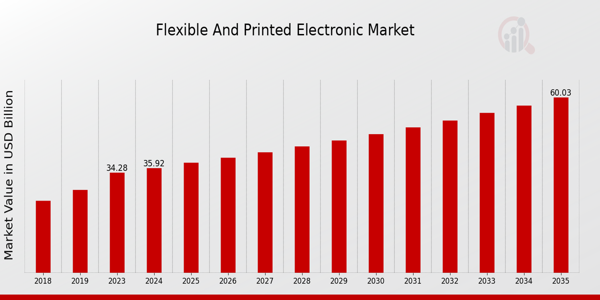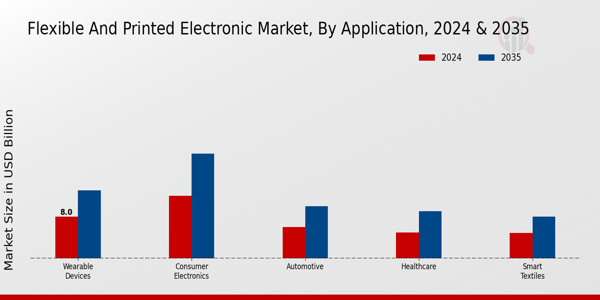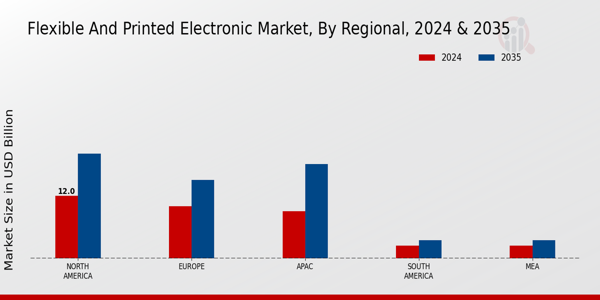Global Flexible and Printed Electronic Market Overview
The Flexible and Printed Electronic Market Size was estimated at 34.28 (USD Billion) in 2023. The Flexible and Printed Electronic Market Industry is expected to grow from 35.92 (USD Billion) in 2024 to 60.0 (USD Billion) by 2035. The Flexible and Printed Electronic Market CAGR (growth rate) is expected to be around 4.78% during the forecast period (2025 - 2035).
Key Flexible and Printed Electronic Market Trends Highlighted
The Flexible and Printed Electronic Market is expanding at an impressive rate owing to developments in technology and the growing need for easier-to-carry and more adaptable electronic devices. Smart wearables and electronic textiles have increased market opportunities. Such developments are encouraged by an increased concern for energy efficiency and sustainability which in return causes innovations in new materials and processes. Moreover, the increasing demand for flexible displays in consumer electronics and automobiles is also aiding the growth of the market. Likewise, a large number of flexible electronics opportunities are available for healthcare, such as patient monitoring systems and wearable health technology. Moreover, the expanding Internet of Things (IoT) ecosystem presents a promising avenue for growth, as flexible electronics can enable smarter and more connected devices across various applications. Companies that can harness these opportunities will likely achieve a competitive edge in this evolving market. In recent times, sustainability has become a critical focus for manufacturers, encouraging the development of eco-friendly materials and recyclable products. The integration of renewable energy sources with flexible electronics is also gaining traction. Furthermore, partnerships and collaborations among industry players are on the rise, facilitating innovation and ensuring the rapid development of new technologies. As the market continues to evolve, a shift toward enhanced manufacturing processes and reducing production costs while optimizing performance is evident. This blend of trends, opportunities, and market drivers indicates a dynamic landscape for the flexible and printed electronic market in the foreseeable future.

Source: Primary Research, Secondary Research, MRFR Database and Analyst Review
Flexible and Printed Electronic Market Drivers
Growing Adoption of Flexible Displays
The increasing demand for flexible displays is one of the most significant drivers of growth in the Flexible and Printed Electronic Market Industry. Flexible displays are being integrated into various devices, such as smartphones, wearables, and televisions, thanks to their lightweight and space-saving attributes. As consumers seek more portable and user-friendly electronic devices, manufacturers are heavily investing in flexible display technologies. This shift towards more versatile and efficient designs is anticipated to boost market growth substantially. The advancements in materials such as organic light-emitting diodes (OLEDs) and improved production technologies have propelled the innovation of flexible displays, making them more accessible. These displays offer the advantage of being thinner, lighter, and more durable compared to traditional display technologies. Furthermore, the growing interest in sustainable and eco-friendly products has led to increased investments in printed and flexible electronics, contributing to the transition from conventional to flexible form factors. The market for wearable electronics, such as health monitoring devices, is also surging, further driving the demand for flexible displays. This overall trend toward adoption and innovation is expected to have a long-lasting impact on the industry as flexible display technologies become essential components in various applications and sectors. Thus, the growing adoption of flexible displays will continue to shape the landscape of the Flexible and Printed Electronic Market, fostering a positive outlook for future growth.
Technological Advancements in Manufacturing Processes
Technological advancements in manufacturing processes are facilitating higher efficiency and lower costs in producing flexible and printed electronics. Innovations such as roll-to-roll printing and improvements in materials enable manufacturers to enhance production quality and scale. This is crucial for meeting the growing demand while maintaining cost-effectiveness in the Flexible and Printed Electronic Market Industry. As these technologies evolve, the ability to produce high-quality flexible electronics at a lower price point will likely stimulate market expansion.
Increasing Application Areas in Various Industries
The expansion of application areas in various industries significantly drives the growth of the Flexible and Printed Electronic Market. Sectors such as healthcare, automotive, and consumer electronics are increasingly incorporating flexible electronics in their products, offering enhanced functionalities and innovative features. This diversification of applications is continually paving the way for more opportunities and market growth.
Flexible and Printed Electronic Market Segment Insights
Flexible and Printed Electronic Market Application Insights
The Application segment of the Flexible and Printed Electronic Market showcases diverse and dynamic growth, primarily through its pivotal categories, including Wearable Devices, Consumer Electronics, Automotive, Healthcare, and Smart Textiles. In 2024, the market significantly contributed with a range of valuations across these applications, leading to an overall assessment of the industry. Wearable Devices emerge as a substantial component, holding a valuation of 8.0 USD Billion in 2024, indicating the rising demand for health and fitness monitoring technologies that are integrated into everyday accessories. Consumer Electronics dominate the segment with a notable valuation of 12.0 USD Billion in 2024, driven by the increasing penetration of flexible electronics in smartphones and tablets, enhancing user interaction and product aesthetics. The Automotive sector, valued at 6.0 USD Billion in 2024, is experiencing a transformation with the integration of printed electronics for advanced safety systems and infotainment solutions, improving driver experiences and operational efficiency.
Healthcare applications are also gaining traction, with a valuation of 5.0 USD Billion in 2024, reflecting the growing reliance on portable diagnostic devices and patient monitoring systems that contribute to better healthcare outcomes. Meanwhile, Smart Textiles, valued at 4.92 USD Billion in 2024, signifies the innovative potential of integrating electronic functionalities into textiles, catering to specialized industries ranging from fashion to safety. Each of these applications plays a significant role in molding the future landscape of the Flexible and Printed Electronic Market, as they cater to the evolving demands for multifunctional, energy-efficient, and user-friendly electronic solutions across various sectors. The majority holding of the Consumer Electronics category illustrates its extensive impact and capacity for innovation, which fuels the overall market growth. Each segment showcases unique drivers and challenges, such as technological advancements, regulatory factors, and market competition, thus creating ample opportunities for growth and investment within the Flexible and Printed Electronic Market. As the market data for subsequent years indicates continued expansion, these applications are likely to witness further evolution and refinement in their offerings, paving the way for enhanced societal benefits and technological advancements in the coming years.

Source: Primary Research, Secondary Research, MRFR Database and Analyst Review
Flexible and Printed Electronic Market Material Insights
The Flexible and Printed Electronic Market, particularly within the Material segment, is poised for significant advancement as it strives towards a market valuation of 35.92 billion USD by 2024. This market encompasses various crucial components, including Conductive Ink, Substrate Materials, Encapsulation Materials, and Semiconductors, each contributing to the overall industry growth. Conductive Ink is instrumental in its role in enabling electrical connections on flexible substrates, while Substrate Materials are vital for providing essential support and functionality to electronic devices. Encapsulation Materials protect sensitive components from environmental factors, ensuring longevity and reliability. Moreover, Semiconductors are pivotal, as they are the core of electronic functionality, influencing overall performance. The steady growth in demand for lightweight, flexible, and efficient electronic solutions fuels the market expansion, driven by increasing applications in consumer electronics, healthcare, and automotive industries. However, challenges such as cost management and technological limitations remain significant. The Flexible and Printed Electronic Market data indicates that while various players contribute to the overall market growth, a pivotal focus on advanced materials can unlock new opportunities for innovation and efficiency.
Flexible and Printed Electronic Market Technology Insights
The Flexible and Printed Electronic Market, within the Technology segment, is characterized by robust growth, with the market valued at 35.92 billion USD in 2024 and expected to reach 60.0 billion USD by 2035. This segment encompasses various technologies such as Screen Printing, Inkjet Printing, Roll-to-Roll Printing, and Flexographic Printing, each playing a crucial role in the market's expansion. Screen Printing remains a major player due to its ease of implementation and capacity for high-volume production, supporting diverse applications across industries. Inkjet Printing contributes with its flexibility and precision, making it suitable for customized designs and rapid prototyping. Roll-to-roll printing also holds significant importance, enabling continuous processing and reducing production costs, which is increasingly appealing in today's fast-paced manufacturing environment. Flexographic Printing is notable for its efficiency and ability to handle various substrates efficiently, catering to packaging solutions. Market trends show a rising demand for lightweight, flexible electronic solutions, driven by advancements in consumer electronics and the growing adoption of smart devices, further feeding the Flexible and Printed Electronic Market revenue and statistics. However, the industry faces challenges, such as the need for advanced materials and processes to enhance the durability and performance of printed electronics. Overall, the Flexible and Printed Electronic Market segmentation highlights diverse opportunities and growth prospects that are shaping the industry's future.
Flexible and Printed Electronic Market End-Use Insights
The Flexible and Printed Electronic Market was valued at 35.92 USD billion in 2024, showcasing robust growth driven by a variety of end-use sectors. This market encompasses applications in industrial, commercial, and residential sectors, each contributing to the market's overall dynamics. The industrial segment plays a crucial role, as it often leverages flexible electronics for automated systems and sensor technology, enabling enhanced operational efficiency. Meanwhile, the commercial sector significantly benefits from printed electronics in advertising displays and smart packaging solutions, creating attractive avenues for brand engagement. Residential applications, though typically smaller in scale, are gaining traction through innovations in wearable technology and smart home devices, engaging consumers with advanced functionalities. The growth trajectory for these end-use segments reflects increasing demand for lightweight, adaptable electronic solutions, highlighting the overall market's progression as it continues to evolve with technological advancements. The Flexible and Printed Electronic Market data indicates that as these sectors expand, they present noteworthy opportunities and challenges, further shaping market growth and ultimately influencing Flexible and Printed Electronic Market statistics.
Flexible and Printed Electronic Market Regional Insights
The Regional segmentation of the Flexible and Printed Electronic Market reveals significant insights about market distribution and growth potential across different areas. In 2024, North America leads with a valuation of 12.0 USD Billion, projected to rise to 20.0 USD Billion by 2035, showcasing its importance due to advanced technology adoption and a well-established manufacturing base. Europe follows closely, starting at 10.0 USD Billion in 2024 and expected to grow to 15.0 USD Billion, driven by innovation in consumer electronics and automotive sectors. The APAC region showcases a notable surge, with its market valued at 9.0 USD Billion in 2024, anticipated to expand to 18.0 USD Billion as the demand for electronic products increases in emerging economies. South America and the MEA regions, with values of 2.5 USD Billion and 2.42 USD Billion, respectively, in 2024, indicate growth opportunities, although they represent a smaller share of the overall market. The overall Flexible and Printed Electronic Market revenue reflects a dynamic landscape where North America and Europe continue to dominate, but the APAC region exemplifies rapid growth potential, further emphasizing the importance of understanding regional dynamics through Flexible and Printed Electronic Market data and statistics.

Source: Primary Research, Secondary Research, MRFR Database and Analyst Review
Flexible and Printed Electronic Market Key Players and Competitive Insights
The Flexible and Printed Electronic Market has experienced significant growth due to the increasing demand for lightweight and energy-efficient electronic devices across various applications. This market encompasses a broad range of technologies, including organic light-emitting diodes, organic photovoltaic cells, and flexible sensors, which are utilized in consumer electronics, wearable devices, and smart packaging, among others. The competitive landscape is shaped by a mix of established players and innovative start-ups, all vying to leverage advancements in materials science, manufacturing processes, and integration techniques. The push for sustainability and eco-friendly solutions further intensifies competition as companies explore novel materials and production methods aimed at reducing environmental impact while enhancing performance and functionality. Fraunhofer Institute stands out in the Flexible and Printed Electronic Market due to its strong emphasis on research and development pioneering advancements in various flexible electronics technologies. The institute's robust capabilities in material science allow it to develop cutting-edge solutions that focus not only on productivity but also on sustainability, making significant contributions to both academic and industrial advancements in the sector. Their collaborations with various industries and academic entities foster an environment of innovation, facilitating the transfer of knowledge and technology, which enhances their market presence. Furthermore, the institute's commitment to optimizing manufacturing processes and identifying new applications for printed electronics ensures that it maintains its competitive edge, positioning itself as a leader in the development of flexible and printed electronics solutions that cater to diverse market needs.
Dai Nippon Printing has established a formidable presence in the Flexible and Printed Electronic Market, accentuated by its extensive experience in printed electronics and advanced manufacturing techniques. The company's strengths lie in its capabilities to produce high-quality, printed components that are integral to the performance of flexible electronic devices. With substantial investments in research and development, Dai Nippon Printing is at the forefront of innovation in flexible displays, printed sensors, and intelligent packaging solutions. Their strategic partnerships and collaborations within the industry enhance their ability to offer comprehensive solutions while keeping pace with emerging trends and customer demands. Furthermore, Dai Nippon Printing's focus on a sustainable approach in its operations and product offerings aligns with evolving market expectations, ensuring its position as a significant player in the competitive landscape of flexible and printed electronics.
Key Companies in the Flexible and Printed Electronic Market Include
- Fraunhofer Institute
- Dai Nippon Printing
- AGC Inc
- Samsung Electronics
- Heliatek
- Novacentrix
- Hewlett Packard
- Printed Electronics Limited
- Thin Film Electronics
- Toppan Printing
- Konica Minolta
- GSI Technologies
- Eastman Kodak
- E Ink Holdings
- LG Display
Flexible and Printed Electronic Industry Developments
In recent months, the Flexible and Printed Electronics Market has seen significant developments, particularly with companies such as Samsung Electronics and LG Display advancing their technologies for OLED displays. The Fraunhofer Institute has been actively exploring eco-friendly materials for printed electronics, bolstering sustainability within the market. Notably, Dai Nippon Printing continues to innovate in flexible solar cells, while Heliatek has made strides in organic photovoltaics, attracting attention for their renewable energy potential. In terms of mergers and acquisitions, there have been discussions around potential collaborations, especially involving Eastman Kodak and Toppan Printing, although specific details remain under wraps. Novacentrix has also been expanding its capabilities in printed electronics manufacturing, emphasizing the importance of production scalability. Companies like Printed Electronics Limited and Thin Film Electronics are enhancing their offerings, reflecting a growing demand for flexible materials across multiple applications. Financial performance in this sector has shown positive trends, with many firms reporting increased market valuations, driven by rising adoption in electronic devices and the automotive industry. This momentum is shaping a robust landscape for future investments and technological advancements in flexible and printed electronics.
Flexible and Printed Electronic Market Segmentation Insights
Flexible and Printed Electronic Market Application Outlook
- Wearable Devices
- Consumer Electronics
- Automotive
- Healthcare
- Smart Textiles
Flexible and Printed Electronic Market Material Outlook
- Conductive Ink
- Substrate Materials
- Encapsulation Materials
- Semiconductors
Flexible and Printed Electronic Market Technology Outlook
- Screen Printing
- Inkjet Printing
- Roll-to-Roll Printing
- Flexographic Printing
Flexible and Printed Electronic Market End-Use Outlook
- Industrial
- Commercial
- Residential
Flexible and Printed Electronic Market Regional Outlook
- North America
- Europe
- South America
- Asia-Pacific
- Middle East and Africa
| Attribute/Metric Source: |
Details |
| MARKET SIZE 2023 |
34.28(USD Billion) |
| MARKET SIZE 2024 |
35.92(USD Billion) |
| MARKET SIZE 2035 |
60.0(USD Billion) |
| COMPOUND ANNUAL GROWTH RATE (CAGR) |
4.78% (2025 - 2035) |
| REPORT COVERAGE |
Revenue Forecast, Competitive Landscape, Growth Factors, and Trends |
| BASE YEAR |
2024 |
| MARKET FORECAST PERIOD |
2025 - 2035 |
| HISTORICAL DATA |
2019 - 2024 |
| MARKET FORECAST UNITS |
USD Billion |
| KEY COMPANIES PROFILED |
Fraunhofer Institute, Dai Nippon Printing, AGC Inc, Samsung Electronics, Heliatek, Novacentrix, Hewlett Packard, Printed Electronics Limited, Thin Film Electronics, Toppan Printing, Konica Minolta, GSI Technologies, Eastman Kodak, E Ink Holdings, LG Display |
| SEGMENTS COVERED |
Application, Material, Technology, End Use, Regional |
| KEY MARKET OPPORTUNITIES |
Wearable technology integration, Smart packaging solutions, Energy harvesting applications, E-health monitoring devices, Automotive electronics enhancement |
| KEY MARKET DYNAMICS |
growing demand for wearables, technological advancements in printing, rise of smart packaging, increasing investment in R&D, environmental sustainability focus |
| COUNTRIES COVERED |
North America, Europe, APAC, South America, MEA |
Frequently Asked Questions (FAQ) :
The Global Flexible and Printed Electronic Market is expected to be valued at 35.92 USD Billion in 2024.
By 2035, the market is projected to reach a value of 60.0 USD Billion.
The market is expected to grow at a CAGR of 4.78% from 2025 to 2035.
North America is expected to dominate the market with a value of 20.0 USD Billion by 2035.
In 2035, the projected market values are 13.0 USD Billion for Wearable Devices, 20.0 USD Billion for Consumer Electronics, 10.0 USD Billion for Automotive, 9.0 USD Billion for Healthcare, and 8.0 USD Billion for Smart Textiles.
The APAC region's market size is expected to be valued at 9.0 USD Billion in 2024.
Key players include Fraunhofer Institute, Dai Nippon Printing, AGC Inc, Samsung Electronics, and Heliatek among others.
The Healthcare application is expected to grow to 9.0 USD Billion by 2035.
The market value for South America is projected to reach 3.5 USD Billion by 2035.
The European market is estimated to be worth 10.0 USD Billion in 2024.

















